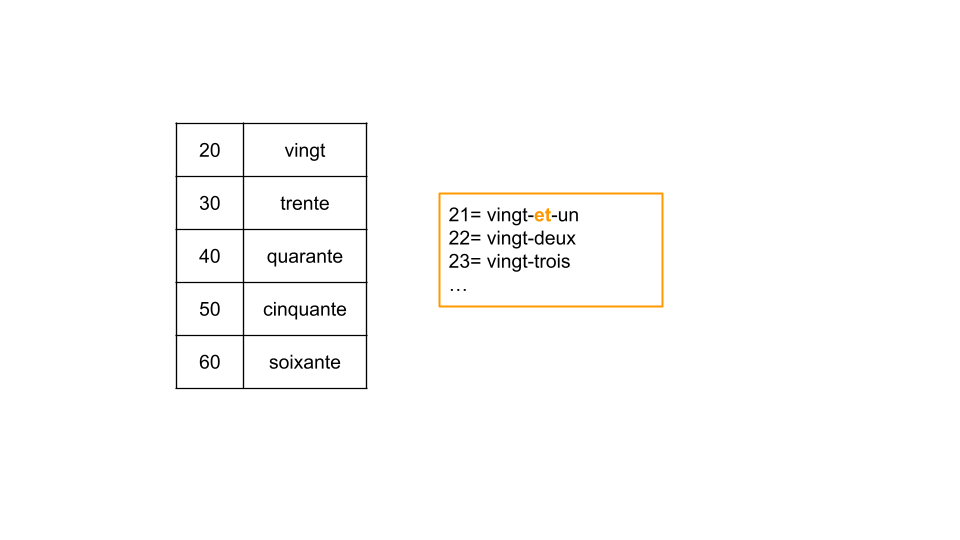1.9: On découvre - les nombres cardinaux
- Page ID
- 257929
\( \newcommand{\vecs}[1]{\overset { \scriptstyle \rightharpoonup} {\mathbf{#1}} } \)
\( \newcommand{\vecd}[1]{\overset{-\!-\!\rightharpoonup}{\vphantom{a}\smash {#1}}} \)
\( \newcommand{\dsum}{\displaystyle\sum\limits} \)
\( \newcommand{\dint}{\displaystyle\int\limits} \)
\( \newcommand{\dlim}{\displaystyle\lim\limits} \)
\( \newcommand{\id}{\mathrm{id}}\) \( \newcommand{\Span}{\mathrm{span}}\)
( \newcommand{\kernel}{\mathrm{null}\,}\) \( \newcommand{\range}{\mathrm{range}\,}\)
\( \newcommand{\RealPart}{\mathrm{Re}}\) \( \newcommand{\ImaginaryPart}{\mathrm{Im}}\)
\( \newcommand{\Argument}{\mathrm{Arg}}\) \( \newcommand{\norm}[1]{\| #1 \|}\)
\( \newcommand{\inner}[2]{\langle #1, #2 \rangle}\)
\( \newcommand{\Span}{\mathrm{span}}\)
\( \newcommand{\id}{\mathrm{id}}\)
\( \newcommand{\Span}{\mathrm{span}}\)
\( \newcommand{\kernel}{\mathrm{null}\,}\)
\( \newcommand{\range}{\mathrm{range}\,}\)
\( \newcommand{\RealPart}{\mathrm{Re}}\)
\( \newcommand{\ImaginaryPart}{\mathrm{Im}}\)
\( \newcommand{\Argument}{\mathrm{Arg}}\)
\( \newcommand{\norm}[1]{\| #1 \|}\)
\( \newcommand{\inner}[2]{\langle #1, #2 \rangle}\)
\( \newcommand{\Span}{\mathrm{span}}\) \( \newcommand{\AA}{\unicode[.8,0]{x212B}}\)
\( \newcommand{\vectorA}[1]{\vec{#1}} % arrow\)
\( \newcommand{\vectorAt}[1]{\vec{\text{#1}}} % arrow\)
\( \newcommand{\vectorB}[1]{\overset { \scriptstyle \rightharpoonup} {\mathbf{#1}} } \)
\( \newcommand{\vectorC}[1]{\textbf{#1}} \)
\( \newcommand{\vectorD}[1]{\overrightarrow{#1}} \)
\( \newcommand{\vectorDt}[1]{\overrightarrow{\text{#1}}} \)
\( \newcommand{\vectE}[1]{\overset{-\!-\!\rightharpoonup}{\vphantom{a}\smash{\mathbf {#1}}}} \)
\( \newcommand{\vecs}[1]{\overset { \scriptstyle \rightharpoonup} {\mathbf{#1}} } \)
\( \newcommand{\vecd}[1]{\overset{-\!-\!\rightharpoonup}{\vphantom{a}\smash {#1}}} \)
\(\newcommand{\avec}{\mathbf a}\) \(\newcommand{\bvec}{\mathbf b}\) \(\newcommand{\cvec}{\mathbf c}\) \(\newcommand{\dvec}{\mathbf d}\) \(\newcommand{\dtil}{\widetilde{\mathbf d}}\) \(\newcommand{\evec}{\mathbf e}\) \(\newcommand{\fvec}{\mathbf f}\) \(\newcommand{\nvec}{\mathbf n}\) \(\newcommand{\pvec}{\mathbf p}\) \(\newcommand{\qvec}{\mathbf q}\) \(\newcommand{\svec}{\mathbf s}\) \(\newcommand{\tvec}{\mathbf t}\) \(\newcommand{\uvec}{\mathbf u}\) \(\newcommand{\vvec}{\mathbf v}\) \(\newcommand{\wvec}{\mathbf w}\) \(\newcommand{\xvec}{\mathbf x}\) \(\newcommand{\yvec}{\mathbf y}\) \(\newcommand{\zvec}{\mathbf z}\) \(\newcommand{\rvec}{\mathbf r}\) \(\newcommand{\mvec}{\mathbf m}\) \(\newcommand{\zerovec}{\mathbf 0}\) \(\newcommand{\onevec}{\mathbf 1}\) \(\newcommand{\real}{\mathbb R}\) \(\newcommand{\twovec}[2]{\left[\begin{array}{r}#1 \\ #2 \end{array}\right]}\) \(\newcommand{\ctwovec}[2]{\left[\begin{array}{c}#1 \\ #2 \end{array}\right]}\) \(\newcommand{\threevec}[3]{\left[\begin{array}{r}#1 \\ #2 \\ #3 \end{array}\right]}\) \(\newcommand{\cthreevec}[3]{\left[\begin{array}{c}#1 \\ #2 \\ #3 \end{array}\right]}\) \(\newcommand{\fourvec}[4]{\left[\begin{array}{r}#1 \\ #2 \\ #3 \\ #4 \end{array}\right]}\) \(\newcommand{\cfourvec}[4]{\left[\begin{array}{c}#1 \\ #2 \\ #3 \\ #4 \end{array}\right]}\) \(\newcommand{\fivevec}[5]{\left[\begin{array}{r}#1 \\ #2 \\ #3 \\ #4 \\ #5 \\ \end{array}\right]}\) \(\newcommand{\cfivevec}[5]{\left[\begin{array}{c}#1 \\ #2 \\ #3 \\ #4 \\ #5 \\ \end{array}\right]}\) \(\newcommand{\mattwo}[4]{\left[\begin{array}{rr}#1 \amp #2 \\ #3 \amp #4 \\ \end{array}\right]}\) \(\newcommand{\laspan}[1]{\text{Span}\{#1\}}\) \(\newcommand{\bcal}{\cal B}\) \(\newcommand{\ccal}{\cal C}\) \(\newcommand{\scal}{\cal S}\) \(\newcommand{\wcal}{\cal W}\) \(\newcommand{\ecal}{\cal E}\) \(\newcommand{\coords}[2]{\left\{#1\right\}_{#2}}\) \(\newcommand{\gray}[1]{\color{gray}{#1}}\) \(\newcommand{\lgray}[1]{\color{lightgray}{#1}}\) \(\newcommand{\rank}{\operatorname{rank}}\) \(\newcommand{\row}{\text{Row}}\) \(\newcommand{\col}{\text{Col}}\) \(\renewcommand{\row}{\text{Row}}\) \(\newcommand{\nul}{\text{Nul}}\) \(\newcommand{\var}{\text{Var}}\) \(\newcommand{\corr}{\text{corr}}\) \(\newcommand{\len}[1]{\left|#1\right|}\) \(\newcommand{\bbar}{\overline{\bvec}}\) \(\newcommand{\bhat}{\widehat{\bvec}}\) \(\newcommand{\bperp}{\bvec^\perp}\) \(\newcommand{\xhat}{\widehat{\xvec}}\) \(\newcommand{\vhat}{\widehat{\vvec}}\) \(\newcommand{\uhat}{\widehat{\uvec}}\) \(\newcommand{\what}{\widehat{\wvec}}\) \(\newcommand{\Sighat}{\widehat{\Sigma}}\) \(\newcommand{\lt}{<}\) \(\newcommand{\gt}{>}\) \(\newcommand{\amp}{&}\) \(\definecolor{fillinmathshade}{gray}{0.9}\)1. On apprend
Le vocabulaire utile : les nombres

A. Comment dit-on :
33 ? 38 ? 39 ?
42 ? 45 ? 47 ?
51 ? 54 ? 56 ?
61 ? 68 ? 69
B. On calcule !
** Potential ADAPT/H5P problem
Write out the following math problems. Here are some common mathematical operator.
|
10 + 9 = 18 + 7 = 29 + 4 = 45 + 19 = 16 - 5 = 57 - 6 = 36 + 13 = 34 - 7 = |
Quel est votre numéro préféré ou de chance (=your lucky number) ?
2. On s'entraîne : Les numéros de téléphone
How would you explain to a foreigner how phone area codes work in the US. How do you tell a mobile phone number from a landline and other commercial numbers (toll free, etc.)?
Voici les indicatifs téléphoniques (=area codes) pour les numéros de téléphone fixes en France :

Babsy, CC BY 3.0
- Les numéros de téléphone mobiles commencent par (start with) 06 ou 07.
- Les numéros de téléphone ont 10 chiffres :
04-68-02-27-52 = [zéro quatre] - [soixante-huit] - [zéro deux] - [vingt-sept] - [cinquante-deux].
- This number is from a landline in the south east part of France.
- This number is from a mobile phone: 06-08-34-56-10 = [zéro six] - [zéro huit] - [trente-quatre] -[cinquante-six] - [dix].
** Potential ADAPT/H5P problem
Listen as your teacher gives the addresses and telephone numbers of three people and complete the table below:
|
Modèle : Bastien. You hear son adresse c’est le 15 rue de la Libération et son numéro c’est le 04-61-02-27-52. You write: 15 and 04-61-02-27-52 |
|
Adresse |
Numéro de téléphone |
|
|
1. Laila |
|
|
|
2. Anita |
|
|
|
3. Karine |
|
In the European Union, there is one number to call for emergencies: 112. What is the number to call for an emergency in your country? Can you say it in French?

To practice more go to: Les numéros de téléphone
To know more: C'est quoi, les numéros d'urgence ? - 1jour1actu.com
For fun: watch this clip made by Swiss firefighters to raise awareness about the correct number to dial in case of emergency: 118 Projec't - LE CLIP OFFICIEL des Pompiers Suisse Romand
A. On lit
Lisez (=read) les deux dialogues et ensuite écoutez et répétez avec votre partenaire.
Dialogue informel
|
|
|
|
Dialogue formel
|
|
|
|
B. On y go !
Imaginez un numéro de téléphone français (write it down and hide it). Now act out each of the dialogues with a partner.
Given that you have only learned to count up to 69, how could you try to say your number in French?
C. Les numéros de téléphone dans les pays francophones
Choose a francophone country (Benin, Belgium, Ivory Coast, Senegal, Switzerland, Morocco…) and research the format they use for phone numbers and emergency numbers (hospital, police, fire department, etc.). Share your findings with your partners. Which system is most like the country you live in?
3. On traduit
** Potential ADAPT/H5P problem
Comment dit-on ? Translate the following sentences.
|
In English: |
En français : |
|
Here’s the book.. |
|
|
There are twenty-one students in the classroom.. |
|
|
In my backpack, there is a laptop.. |
|
|
Who is that? It’s Mrs. Perraise. |
|
|
What's your number (informal)? |
|
|
What's your number (formal)? |
|
|
They (nonbinary) are an architect. |
Ch 1 Devoirs 5


